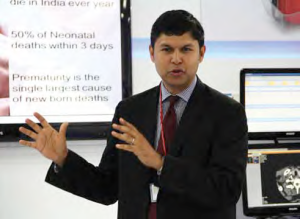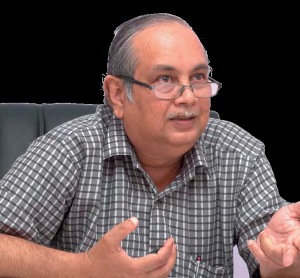Krishna Kumar,
President,
Healthcare Technology
With new range of products being launched at the Philips Innovation Centre in Bangalore, Krishna Kumar, President Healthcare Technology, talks about how Philips has made healthcare technology affordable and simplistic to SrutiGhoshal, ENN.

When we first launched the three test layer MRI scanner, which was the first in the world, AIIMS was one of the first adopters.
In 2012 you announced the commencement of operations at the first Greenfield manufacturing facility in the imaging system in the country.What was the reason behind setting it up and how has it benefited the healthcare market in India?
Any emerging market in India has huge population and huge disease states on the one hand and addressing the three classic As that is awareness,access and affordability. Philips has been one of the longest serving MNC in the country and we have had our presence over 80 years. So when we draw a long term strategic plan for the country it becomes important for us to address the key issues and it can be only fulfilled if we build an end to end eco-system in the country. The access challenge is huge, both physical and geographical access and financial access to technology as well and affordability also remains a huge challenge. Today cardiac disease is one of the top killers in the country and we have 60 million people with heart disease and only two million angiography being performed in the country, which is one of the lowest in the world. The fundamental reason is not a dearth of cardiologist but the dearth of number of cardiac centres in the country and underneath this challenge lays in the unaffordability of technology. Out of our Greenfield facility in Pune, we have built an entire ecosystem of products ranging from worlds most affordable cath labs to a wide range of cathlabs. And today because of this investment today we have been able to bring the most affordable cath lab which now starts from `70 lakhs.
How has Philips Healthcare Technologies penetrated the tier I and tier II cities in India?
We are probably one of the best penetrated MNC in the country, certainly in the lighting space. In healthcare, the rural market predominantly gets addressed through the National Rural Health Mission, so our products go through NRHM. In urban space we are serving nearly 700 cities in the country

Factsheet
India spent 4.8 percent of its Gross Domestic Product (GDP) on health care in 2003, somewhat less than Chinas 5.6 percent.Translated into per capita total expenditures at an average exchange rate, however, the Chinese spent an average of USD 61 million compared with Indias USD 27 million.
What are the new innovations that you are bringing in sectors like women and child care, cardiology and oncology?In the last two years we launched 33 new products, which have never happened in the history of medical healthcare previously. If we take radiology, we are first one to launch digital broadband MRI scanner, similarly we have also launched a new CT scanner like ingenuity which is today the lowest radiation dose scanner in the world. If you take USG then we are the first company to launch a technology called Xmatrix.We entirely developed a whole new platform called Clear Vue. With this most of the information that used to be with the server has been moved to the probe or the transducer. This is the first time in the world that such technology has happened. With this technology the maternal mortality which is a concern in rural India can be solved where a social worker can actually use the probe. If you talk about critical care we have introduced a whole new range of products. We have launched a few high end ventilators. We have launched the worlds first e-ICU where the patient can be monitored from any where.
 Today cardiac disease is one of the top killers in the country and we have 60 million people with heart disease and only TWO million angiography being performed in the country, which is one of the lowest in the world. The fundamental reason is not a dearth of cardiologist but the dearth of number of cardiac centres in the country and underneath this challenge lays in the unaffordability of technology.” |
unaffordability of t
Have you extended these technologies to the government as well? How has been the response?
Government is the second largest category of hospitals that we serve. Adoption of technology in the private hospital is usually swifter than the government hospitals, but in the leading government hospitals government does take a lead. When we first launched the three test layer MRI scanner, which was the first in the world, AIIMS was one of the first adopters. In the leading government hospitals they are very progressive in terms of adopting technology, but when you go down to the PHC there is a lot of modernisation that is required.
What are the innovations that you are planning to introduce in the healthcare informatics space?
We look at healthcare in four layers. In the foundation level we have HIS, most of its use is for non-clinical applications and above that is Electronic Medical Records(EMR) and EHR. This is characterised by clinical informatics and telemedicine. So our expertise lies in these layers. For cardiology we have a solution called Exelera that stores all the video as well as the image information of the patient. For critical care we have solution called ICCA. We also introduced new range in telemedicine in the field of radiology and critical care.
What is the percentage of market share in medical technologies?
According to the 2012, four out of the five verticals that we play in, we are the market leaders. In radiology we have a 39 percent share, in cardiology we have a 53 percent share, in respiratory we have 53 percent and oncology 26 percent. The source of all these data is COCIR
Be a part of Elets Collaborative Initiatives. Join Us for Upcoming Events and explore business opportunities. Like us on Facebook , connect with us on LinkedIn and follow us on Twitter , Instagram.





